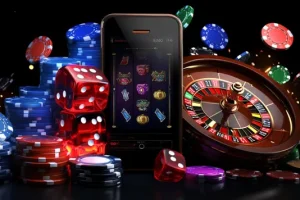Gambling operators have long known that the ‘house always wins’. But they are beginning to learn that this needn’t stop players having a good time – as long as they don’t lose too much. In the past, casinos were like small cities in themselves, with accommodation, shops and restaurants. Today’s venues are more pared-down. They lure visitors in with promises of big winnings (‘a million pounds’, says one sign at the Empire casino in London’s Leicester Square), and keep them there by making their money disappear. The lights never dim and the clocks never change; there aren’t even windows.
Every flashing light, cha-ching jackpot noise, and pleasant background music that greets you in casino gambling rooms isn’t random; rather, they form part of a sophisticated psychological strategy designed to keep you gambling and spending money.
Friedman, known for re-designing Las Vegas, recommends installing playing stations inside corridors near entrances for an intimate feel and to prevent players from leaving the gaming floor too early. Other techniques may include taking steps such as removing clocks to stop people leaving.
Sense of Place
Casino design may appear superficial at first glance, but it actually involves much more. Gaming floors, slot machine placement and even music selection all work to encourage more gambling activity and thus prolong player stays.
Friedman believed that the purpose of casinos was to attract visitors and keep them there, with an ideal layout making it evident from the moment guests entered that they were entering a casino. Furthermore, windows or clocks nearby may act as reminders of outside world and distract gamblers from gambling activities.
Psychology of casino design is an intriguing field to study. Although ethical operatorss avoid employing any psychological principles as tools to manipulate customers, these principles can still help create more engaging and fulfilling experiences for their players.
Illusion of Control
Flashing lights, “cha-ching!” jackpot noises, and smokey casino environments combine to give gamblers a false sense of reality. To remain financially healthy and overall wellbeing it is crucial that gamblers understand this phenomenon in order to make decisions which don’t harm themselves and others.
The illusion of control is a cognitive bias where individuals mistakenly believe they have the power to determine outcomes which, in reality, are determined by chance alone. Gambling can create this dangerous illusion that can have devastating repercussions for personal lives, health and relationships alike.
When there are skill cues present, such as changing the speed of a slot machine or altering the strength of a poker hand, illusion of control becomes particularly apparent. Furthermore, this anticipation of winning increases, further perpetuating gambling and risk-taking behavior.
Variable-Ratio Scheduling
Variable-ratio schedules are partial reinforcement plans wherein the number of responses necessary to earn rewards varies, creating an element of unpredictability and increasing motivation among individuals to continue engaging in behavior.
This type of schedule can be particularly effective at encouraging consistent behaviors, and is frequently implemented in real-life situations like door-to-door sales and loyalty programs. Furthermore, this method is particularly resistant to extinction; people remain motivated to continue engaging in it even after its positive reinforcement has dissipated.
Gambling is a classic example of variable-ratio schedules; one cannot know exactly how many spins or pulls of the lever are necessary before winning big. This unpredictable nature makes gambling highly addictive and hard to break free from.
Audio Elements
Behind the flashy visuals of casino websites lies an ingeniously-crafted design intended to influence player behavior. From vibrant concentric circles and pulsating buttons prompting spins or deck hits, casino websites contain many visual cues designed to keep users engaged for as long as possible.
Audio
In a casino environment, music and sound effects are very important for setting the mood. When people gamble they want excitement; therefore, vibrant noises and spinning wheels should be used because they make them excited. However this might cause problems for people with a gambling addiction if they use auditory cues like these too much so that is why every responsible establishment has to ensure that their audio design does not promote risk taking behaviour by supporting safe gaming practices and offering self-exclusion facilities.
Slot Machines
Slot machines attract players with flashing lights accompanied by the ringing of “cha-ching” at the sight or thought of winning jackpots which in turn prompts them to insert more money than planned.
Another tactic employed by casinos is scenting. They place pleasant smells in areas where one could bet such as near machines or down corridors hoping it will entice passersby into having a flutter. Also chips are allowed as payment instead of cash thus making people feel like they are losing less money psychologically.
Friedman feels that gaming machines should be the focus within casinos and even made part of their decor; he suggests tight rows so customers can get lost among them easily. This may give visitors feelings of claustrophobia or disorientation but it also ensures they lose track of time and how much they have spent which is good for business.












